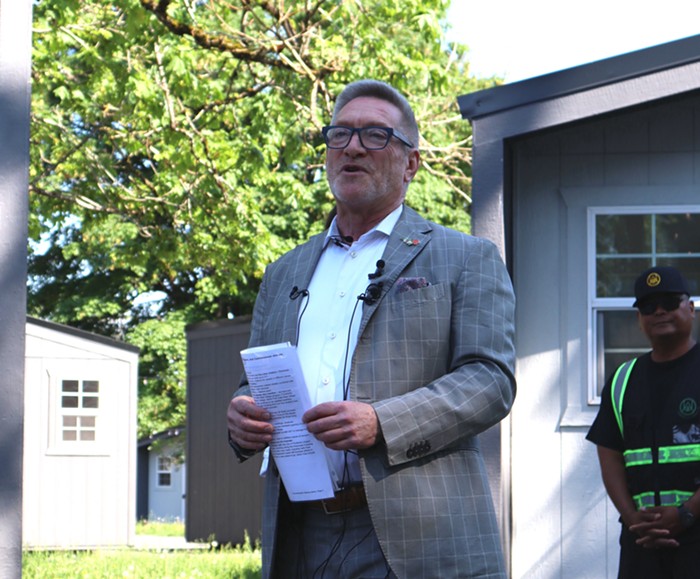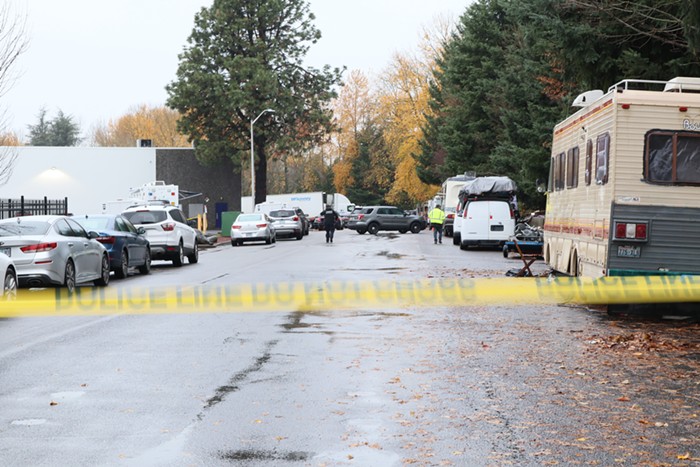Trevor Murphy is on his belly, poking two sticks into an unidentified lump of shit.
"There's a lot of crushed bone and hair in here," he says, tossing the sticks aside and switching to his ungloved fingers. Fellow tracker Norma Schell is leafing through a book called Scat and Tracks, and Murphy tells her out of the side of his mouth to look for the "scat" of the "mountain lion."
Welcome to the decidedly strange world of tracking. It was the last Sunday morning in July when I headed out with my friend, Dalas Verdugo, to Oxbow Park, just east of Portland, to see just what the Portland Trackers were all about. Verdugo had sent me an obscure online posting about the trackers, from the website dirttime.ws, saying only that they met once a month to track things. It piqued my curiosity, and I decided to drag Verdugo along.
"We have a few 200-pound bears and a cougar," explained a park ranger at Oxbow's entrance, when I asked if she knew what, exactly, it was that the trackers tended to track. That's right: bears. Verdugo looked less nervous than I'd expected, on hearing the news.
"This is bear country," I said, thinking of Hunter S. Thompson, and wishing I'd brought along my ether.
Back at the pile of shit, Schell is comparing the scat in her book to the scat in Murphy's hands, which he was bagging to take home and look at, under the microscope. "I think it could be a coyote," says Schell.
Schell learned to track in New Jersey, under the expert tuition of tracker Tom Brown Jr., who gained his tracking skills from a Native American elder named Stalking Wolf. Brown has since made a healthy living tracking lost criminals for the FBI. He's been stabbed, shot at, and come close to death—all in pursuit of tracking. Which makes him my kind of guy. Schell, along with her friends, tend to stick to wild animals. Which, I suppose, is also kind of exciting. In a way.
"I thought of trying to pitch my skills to the sheriff's department," she says. "But there's no way they'd surrender any authority to someone like me."
Schell is a licensed therapist by trade, while Murphy is a drywaller and former smoke jumper out of Prineville, Oregon. Another tracker, Lyn Berkley, is a stay-at-home mom, while an older guy named Geri, who wanders off after 10 minutes not to be seen again, describes himself only as "a hunter."
"These guys all worry about how long [an animal] stood somewhere or what it was doing in a given spot," he says, before leaving. "But I don't really care. I just want to know where I can get at them."
Which may be all very well for Geri. But for Schell, and the others, an animal's presence in the landscape seems to be a matter of Zen significance.
"It's even possible to track human beings' feelings after they've left a room," Schell tells me, as we're waiting for Murphy to finish his dissection.
After deciding the poop is definitely a coyote's, we see some ground squirrel tracks, several deer tracks, and even a classic "beaver drag"—where a beaver drags branches down into the river, leaving its markings behind.
At each sign of tracks, we stop for at least 20 minutes to measure, discuss, and photograph the markings. It's slow paced, and we take roughly two and a half hours to cover less than a mile on the flood plain at Oxbow. We never see any of the animals we're chasing, although by the end of things, I'm more than familiar with what they've left behind.



















